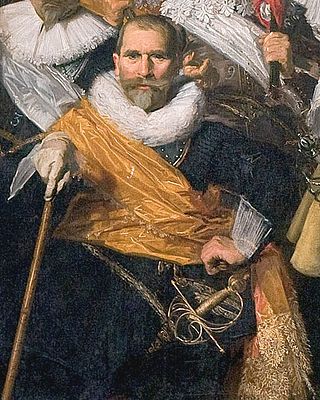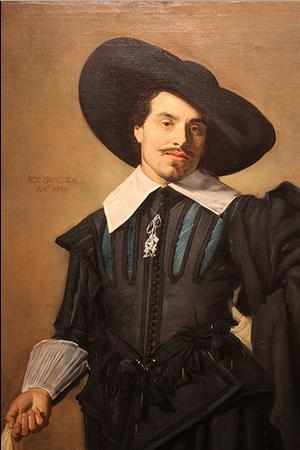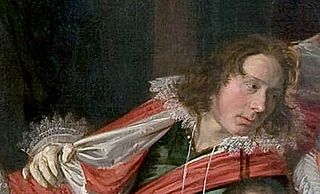
Frans Hals the Elder was a Dutch Golden Age painter. He lived and worked in Haarlem, a city in which the local authority of the day frowned on religious painting in places of worship but citizens liked to decorate their homes with works of art. Hals was highly sought after by wealthy burgher commissioners of individual, married-couple, family, and institutional-group portraits. He also painted tronies for the general market.

The Frans Hals Museum is a museum in the North Holland city of Haarlem, the Netherlands, founded in 1862, known as the Art Museum of Haarlem. Its collection is based on the city's own rich collection, built up from the 16th century onwards. The museum owns hundreds of paintings, including more than a dozen by Frans Hals, to whom the museum owes its name. The Frans Hals Museum has two historic locations in Haarlem city centre: the main location on Groot Heiligland and Location Hal on Grote Markt, composed of the adjacent 17th-century Vleeshal and 19th-century Verweyhal. On Groot Heiligland is the 17th-century Oudemannenhuis with regent's rooms. It houses the famous paintings by Frans Hals and other ancient, modern and contemporary art, as well as the museum café. Location Hal regularly hosts exhibitions of modern and contemporary art.

Cornelis Corneliszoon van Haarlem was a Dutch Golden Age painter and draughtsman, one of the leading Northern Mannerist artists in the Netherlands, and an important forerunner of Frans Hals as a portraitist.

Schutterij refers to a voluntary city guard or citizen militia in the medieval and early modern Netherlands, intended to protect the town or city from attack and act in case of revolt or fire. Their training grounds were often on open spaces within the city, near the city walls, but, when the weather did not allow, inside a church. They are mostly grouped according to their district and to the weapon that they used: bow, crossbow or gun. Together, its members are called a Schuttersgilde, which could be roughly translated as a "shooter's guild". It is now a title applied to ceremonial shooting clubs and to the country's Olympic rifle team.
Johannes Cornelisz Verspronck was a Dutch Golden Age portrait painter from Haarlem.

The Proveniershuis is a hofje and former schutterij on the Grote Houtstraat in Haarlem, Netherlands.

Banquet of the officers of the Calivermen Civic Guard, Haarlem formerly known as The Banquet of the Officers of the St Adrian Militia Company in 1627, refers to a schutterstuk painted by Frans Hals, in 1627, for the St. Adrian civic guard of Haarlem. Today it is considered one of the main attractions of the Frans Hals Museum, in Haarlem.

The Officers of the St Adrian Militia Company in 1633 refers to the second schutterstuk painted by Frans Hals for the Cluveniers, St. Adrian, or St. Hadrian civic guard of Haarlem, in 1633, and today considered one of the main attractions of the Frans Hals Museum there.

The Officers of the St Adrian Militia Company in 1630 refers to the schutterstuk painted by Hendrik Gerritsz Pot for the Cluveniers, St. Adrian, or St. Hadrian civic guard of Haarlem, and today is considered one of the main attractions of the Frans Hals Museum there.

The Banquet of the Officers of the St George Militia Company is an oil-on-canvas painting by the Dutch artist Frans Hals, painted from 1626 - 1627, during the Dutch Golden Age. Today, the piece is considered one of the main attractions of the Frans Hals Museum.

The Officers of the St George Militia Company in 1639 refers to the last and largest schuttersstuk painted by Frans Hals for the St. George civic guard of Haarlem, and today is considered one of the main attractions of the Frans Hals Museum in Haarlem.

Johan Claesz van Loo, was a Dutch brewer, owning De Drie Leliën in Haarlem, best known today for his portrait painted by Frans Hals.

Gijsbert Claesz van Campen, was a Dutch cloth merchant of Haarlem who is most famous today for his family portrait painted by Frans Hals. The sitters in this painting have been identified by Pieter Biesboer as the family of Gijsbert Claesz. van Campen and is today split into three parts; the left half is in the collection of the Toledo Museum of Art, with an extra baby lower left added by Salomon de Bray in 1628, the center half is in the collection of the Royal Museums of Fine Arts of Belgium, Brussels, and a third fragment on the far right from a European private collection make up the three known surviving pieces of the original portrait. These three segments were reunited at the Toledo Museum of Art for an exhibition October 18, 2018 – January 6, 2019. The exhibition traveled to the RMFAB in Brussels from February 2 – April 28, 2019 and the Collection Frits Lugt in Paris, from June 8 – August 25, 2019.

The Meagre Company, or The Company of Captain Reinier Reael and Lieutenant Cornelis Michielsz Blaeuw, refers to the only militia group portrait, or schutterstuk, painted by Frans Hals outside of Haarlem. Today the painting is in the collection of the Amsterdam Museum, on loan to the Rijksmuseum, where it is considered one of its main attractions of the Honor Gallery. Hals was unhappy about commuting to Amsterdam to work on the painting and, unlike his previous group portraits, was unable to deliver it on time. The sitters contracted Pieter Codde to finish the work.

The Haarlem schutterij refers to a collective name for the voluntary civic guard of Haarlem, from medieval times up to the Batavian Revolution in 1794, when the guilds of Haarlem were disbanded.

Cornelis Coning or Koning, was an engraver and mayor of Haarlem.

Jacob Cornelisz Schout, was a Dutch Golden Age member of the Haarlem schutterij.

Cornelis Jacobsz Schout, was a Dutch Golden Age member of the Haarlem schutterij.

Gerrit Cornelisz. Vlasman, was a Dutch Golden Age brewer and member of the Haarlem schutterij.

Loth Schout, was a Dutch Golden Age brewer of Haarlem.























